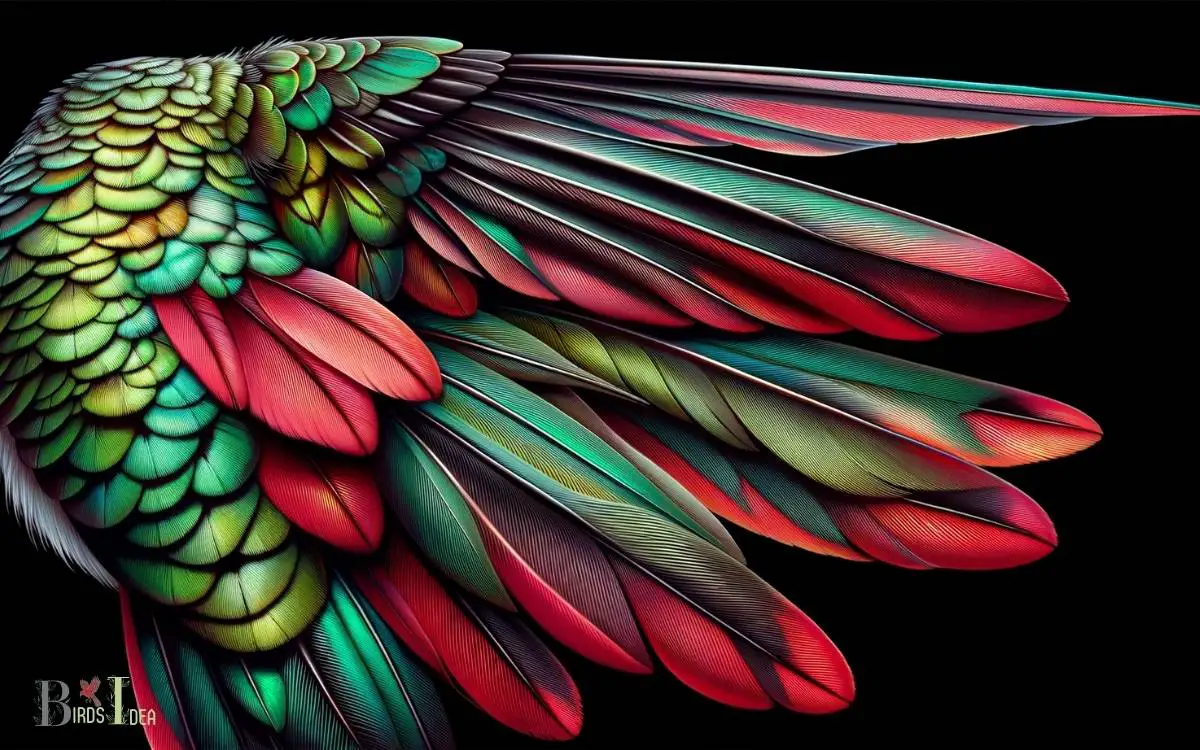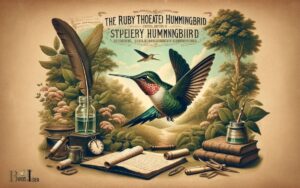Ruby Throated Hummingbird Tail Feathers: Forked Tail!
Ruby-throated Hummingbirds have distinctive tail feathers that play a key role in their flight and courtship displays. Males have a forked tail with pointed feathers, while females have a rounded tail with white tips.
The Ruby-throated Hummingbird, known scientifically as Archilochus colubris, is a species renowned for its iridescent plumage and rapid wingbeats.
The tail feathers of this tiny bird are particularly notable; they are not only used for efficient flight maneuvers but also serve a critical purpose in mating rituals.
Here are some key characteristics:
The distinctive tail feathers of the Ruby-throated Hummingbird are essential for species recognition, mating displays, and aerodynamic control during flight.
The elegant tail feathers of the Ruby-throated Hummingbird serve as a marvel of avian design, blending functionality with an intricate role in their complex mating ballet.

Key Takeaway
Anatomy of the Tail Feathers
The anatomy of the ruby-throated hummingbird tail feathers is a complex structure that plays a crucial role in the bird’s flight and maneuverability.
The tail feathers, or rectrices, are specialized for agility and precision during flight. They are composed of lightweight yet durable keratin, with a central shaft providing stability and vanes extending on either side to control air movement.
The unique shape of the tail feathers, with a slightly forked appearance, allows for enhanced control and stability, enabling the hummingbird to hover, dart, and change direction rapidly.
Additionally, the vibrant iridescent colors of the tail feathers serve a dual purpose, aiding in species recognition and attracting potential mates.
Understanding the intricate design of these feathers provides insight into the exceptional aerial capabilities of the ruby-throated hummingbird.
Functionality in Flight
The tail feathers of the ruby-throated hummingbird play a crucial role in its flight dynamics. These feathers are intricately designed to minimize air resistance and maximize lift, enabling the hummingbird to perform rapid and agile aerial maneuvers with exceptional precision.
Understanding the aerodynamics of these tail feathers provides valuable insights into the remarkable flight capabilities of this tiny avian species.
Tail Feather Aerodynamics
Tail feather aerodynamics play a crucial role in the functionality of a hummingbird’s flight. The shape and arrangement of the tail feathers are essential for providing stability, control, and maneuverability during the bird’s rapid and agile movements.
The table below outlines the key features and functions of the tail feathers in supporting the hummingbird’s aerodynamics.
| Feature | Function |
|---|---|
| Shape | Creates lift and stability, allowing for precision in flight |
| Flexibility | Enables quick adjustments in flight direction and speed |
| Interlocking barbs | Enhances feather strength and reduces air resistance |
| Gradual tapering | Minimizes drag and turbulence, optimizing aerodynamic efficiency |
Understanding the aerodynamics of hummingbird tail feathers provides insight into the remarkable capabilities of these tiny birds, allowing us to appreciate their agility and mastery of flight.
Flight Maneuverability Aid
Flight maneuverability is a critical aspect of a hummingbird’s aerial abilities, allowing it to swiftly navigate its environment with precision and agility. The tail feathers play a key role in this functionality, contributing to the bird’s remarkable aerial dexterity.
The unique shape and arrangement of the tail feathers enable the hummingbird to perform intricate flight maneuvers, including rapid changes in direction, hovering, and precise mid-air adjustments.
The tail feathers provide stability and control during flight, allowing the bird to execute complex aerial feats with remarkable efficiency.
By adjusting the angle and position of its tail feathers, the hummingbird can swiftly respond to changes in its surroundings, making it a master of aerial agility.
This exceptional maneuverability aids the hummingbird in efficiently foraging for nectar and evading potential threats in its environment.
Role in Courtship Displays
During courtship displays, male ruby-throated hummingbirds utilize their tail feathers to perform intricate aerial maneuvers, showcasing their agility and strength to attract potential mates.
The role of the tail feathers in these displays is crucial, as they are used for precise control and stability during the complex flight patterns exhibited by the males.
The following list highlights the significance of these tail feather displays in courtship rituals:
- Attractiveness: The vibrant iridescence and precise movements of the tail feathers capture the attention of potential mates.
- Fitness Indicator: The ability to perform agile aerial displays demonstrates the male’s physical fitness and vigor.
- Mate Selection: Females evaluate the male’s tail feather performance to assess his suitability as a mate.
- Bond Formation: Successful courtship displays create a strong bond between the male and female, leading to potential mating opportunities.
Significance in Territorial Defense
The tail feathers of the Ruby Throated Hummingbird play a crucial role in their territorial defense strategies. These feathers are used in communication between individuals, signaling dominance and ownership of territory.
Understanding the significance of tail feathers in territorial defense sheds light on the intricate social behaviors and communication systems of these fascinating birds.
Tail Feather Communication
Tail feathers play a significant role in territorial defense for Ruby-throated hummingbirds, serving as a key visual communication tool during interactions with intruders. This form of communication is crucial for establishing dominance and maintaining territory.
The following list demonstrates the importance of tail feather communication in territorial defense:
- Intimidation: Vibrant tail displays intimidate intruders and signal the resident hummingbird’s determination to defend its territory.
- Warning: Rapid flicking or fanning of tail feathers warns intruders to stay away, preventing unnecessary physical confrontations.
- Aggression: Aggressive posturing, accompanied by prominent tail feather displays, communicates a clear message of readiness to engage in territorial disputes.
- Establishing Boundaries: Tail feather movements help in delineating territorial boundaries, reducing the likelihood of territorial encroachment.
Understanding the significance of tail feather communication in territorial defense is crucial for appreciating the intricate behaviors of these remarkable birds. This communication also extends to their role in mating rituals.
Role in Mating Rituals
In the context of territorial defense, the role of Ruby-throated hummingbird tail feathers in mating rituals underscores the significance of visual communication in asserting dominance and securing breeding rights.
During mating displays and territorial defense, these iridescent feathers play a crucial role in signaling the bird’s health, vigor, and genetic quality to potential mates and rivals.
The male hummingbirds utilize their vibrant tail feathers to perform aerial displays, showcasing their agility and strength, while simultaneously warding off competing males.
This visual communication is essential for establishing and maintaining territories, as well as for attracting potential mates.
Mating Rituals and Territorial Defense
- Aerial displays
- Territory establishment
- Rival intimidation
- Attracting potential mates
- Signaling genetic quality
This visual communication through tail feathers is a key component of the intricate and dynamic mating rituals of the Ruby-throated hummingbird.
Coloration and Iridescence
Displaying vivid and dynamic hues, the coloration and iridescence of the Ruby Throated Hummingbird’s tail feathers captivate observers with their mesmerizing beauty.
The unique coloration is a result of the microscopic structure of the feathers, which causes light to be refracted, revealing an array of vibrant colors when viewed from different angles.
The iridescence of the feathers serves several important purposes, including:
- Attraction: The bright and iridescent colors play a crucial role in attracting potential mates during courtship displays.
- Camouflage: The iridescence helps the hummingbird blend into its surroundings, offering protection from predators.
- Social Hierarchy: The intensity of the iridescent colors can indicate the dominance and social status of the hummingbird within its community.
- Species Recognition: The distinct coloration and iridescence aid in species recognition and differentiation during interactions within the hummingbird population.
Conservation and Protection
The iridescence and vibrant coloration of the Ruby Throated Hummingbird’s tail feathers make them a focal point for conservation and protection efforts. These tiny birds face numerous threats including habitat loss, climate change, and predation.
Efforts to conserve and protect the Ruby Throated Hummingbird and its beautiful tail feathers involve preserving and restoring their natural habitats, raising awareness about the importance of these birds in pollination, and implementing measures to reduce the impact of climate change.
Additionally, research and monitoring programs are essential for understanding population trends and identifying specific conservation actions.
| Conservation Efforts | Description |
|---|---|
| Habitat Preservation | Protecting and restoring suitable habitats for the birds |
| Awareness Campaigns | Educating the public about the significance of hummingbirds |
| Climate Change Mitigation | Implementing measures to reduce the impact of climate change |
Conservation and protection efforts are crucial to ensuring the continued vibrancy of these magnificent birds and their stunning tail feathers.
Conclusion
The ruby throated hummingbird’s tail feathers play a crucial role in its flight, courtship displays, and territorial defense. The unique coloration and iridescence of these feathers also serve as an important visual signal in the bird’s behavior and communication.
It is imperative to prioritize the conservation and protection of these magnificent birds and their delicate, yet vital, tail feathers in order to maintain the balance of the ecosystem.






